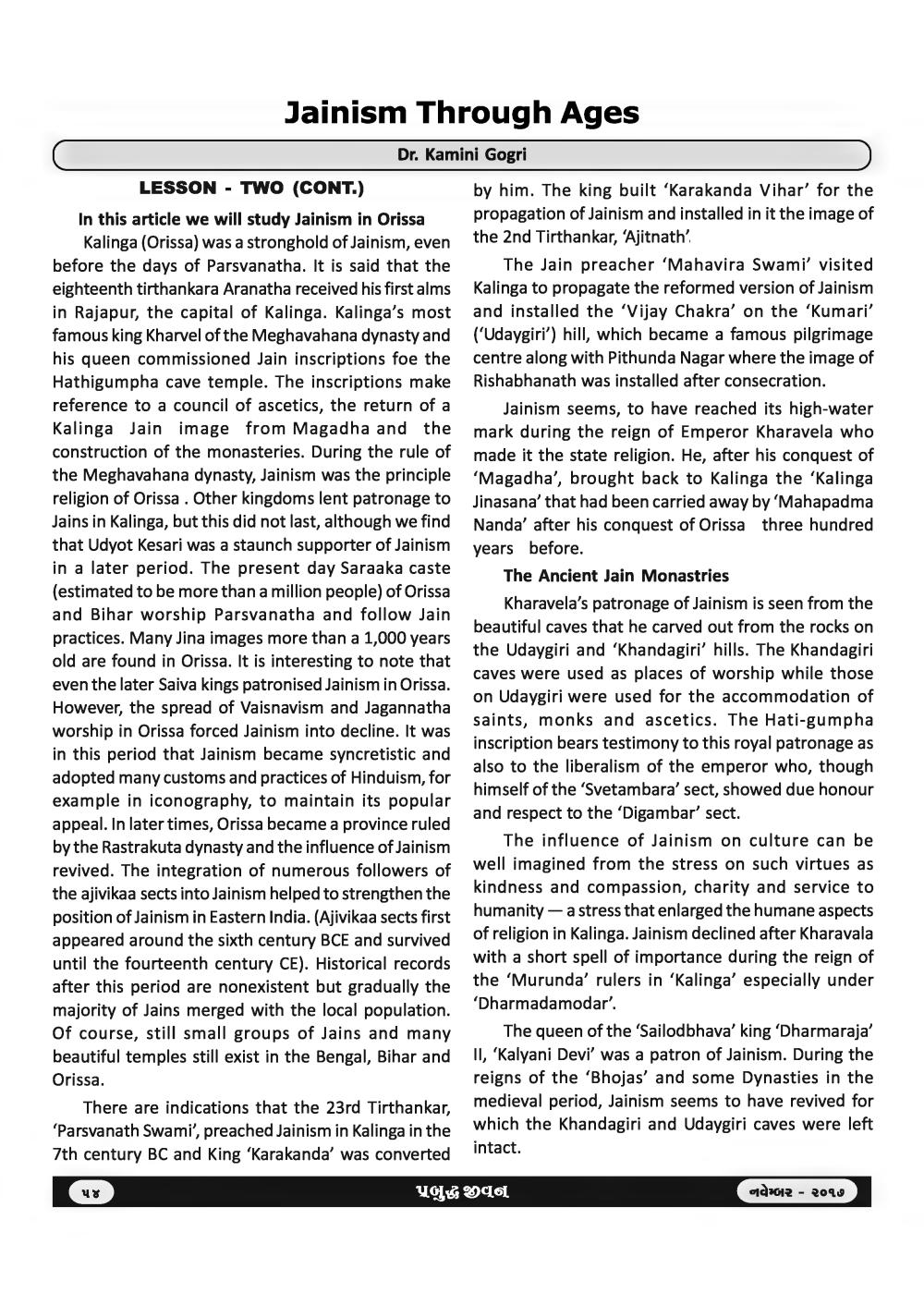________________
Jainism Through Ages
Dr. Kamini Gogri LESSON - TWO (CONT.)
by him. The king built 'Karakanda Vihar' for the In this article we will study Jainism in Orissa
propagation of Jainism and installed in it the image of Kalinga (Orissa) was a stronghold of Jainism, even
the 2nd Tirthankar, 'Ajitnath before the days of Parsvanatha. It is said that the The Jain preacher 'Mahavira Swami' visited eighteenth tirthankara Aranatha received his first alms Kalinga to propagate the reformed version of Jainism in Rajapur, the capital of Kalinga. Kalinga's most and installed the 'Vijay Chakra' on the 'Kumari' famous king Kharvel of the Meghavahana dynasty and ('Udaygiri') hill, which became a famous pilgrimage his queen commissioned Jain inscriptions foe the centre along with Pithunda Nagar where the image of Hathigumpha cave temple. The inscriptions make Rishabhanath was installed after consecration. reference to a council of ascetics, the return of a Jainism seems to have reached its high-water Kalinga Jain image from Magadha and the mark during the reign of Emperor Kharavela who construction of the monasteries. During the rule of made it the state religion. He, after his conquest of the Meghavahana dynasty, Jainism was the principle 'Magadha', brought back to Kalinga the 'Kalinga religion of Orissa. Other kingdoms lent patronage to Jinasana' that had been carried away by 'Mahapadma Jains in Kalinga, but this did not last, although we find Nanda' after his conquest of Orissa three hundred that Udyot Kesari was a staunch supporter of Jainism years before. in a later period. The present day Saraaka caste
The Ancient Jain Monastries (estimated to be more than a million people) of Orissa
Kharavela's patronage of Jainism is seen from the and Bihar worship Parsvanatha and follow Jain
beautiful caves that he carved out from the rocks on practices. Many Jina images more than a 1,000 years
the Udaygiri and 'Khandagiri' hills. The Khandagiri old are found in Orissa. It is interesting to note that
caves were used as places of Worship while those even the later Saiva kings patronised Jainism in Orissa.
on Udaygiri were used for the accommodation of However, the spread of Vaisnavism and Jagannatha
saints, monks and ascetics. The Hati-gumpha worship in Orissa forced Jainism into decline. It was
inscription bears testimony to this royal patronage as in this period that Jainism became syncretistic and
also to the liberalism of the emperor who, though adopted many customs and practices of Hinduism, for
himself of the 'Svetambara' sect, showed due honour example in iconography, to maintain its popular
and respect to the 'Digambar' sect. appeal. In later times, Orissa became a province ruled by the Rastrakuta dynasty and the influence of Jainism
The influence of Jainism on culture can be revived. The integration of numerous followers of
well imagined from the stress on such virtues as the ajivikaa sects into Jainism helped to strengthen the
kindness and compassion, charity and service to position of Jainism in Eastern India. (Aiivikaa sects first humanity - a stress that enlarged the humane aspects appeared around the sixth century BCE and survived
of religion in Kalinga. Jainism declined after Kharavala until the fourteenth century CE). Historical records
with a short spell of importance during the reign of after this period are nonexistent but gradually the
the 'Murunda' rulers in 'Kalinga' especially under
the majority of Jains merged with the local population. Dharmadamodar Of course, still small groups of Jains and many The queen of the 'Sailodbhava' king 'Dharmaraja' beautiful temples still exist in the Bengal, Bihar and II, 'Kalyani Devi' was a patron of Jainism. During the Orissa.
reigns of the 'Bhojas' and some Dynasties in the There are indications that the 23rd Tirthankar,
medieval period, Jainism seems to have revived for 'Parsvanath Swami', preached Jainism in Kalinga in the
which the Khandagiri and Udaygiri caves were left 7th century BC and King 'Karakanda' was converted intact.
પ્રqદ્ધજીવુબ
નવેમ્બર - ૨૦૧૭




